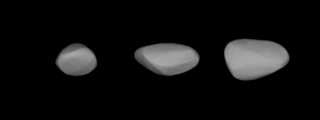
Hecuba is a fairly large and bright main-belt asteroid. It was discovered by Karl Theodor Robert Luther on 2 April 1869, and named after Hecuba, wife of King Priam in the legends of the Trojan War in Greek Mythology. This object is orbiting the Sun with a period of 5.83 years and an eccentricity of 0.06. It became the first asteroid discovered to orbit near a 2:1 mean-motion resonance with the planet Jupiter, and is the namesake of the Hecuba group of asteroids.

Lydia is a large belt asteroid with an M-type spectrum, and thus may be metallic in composition, consisting primarily of nickel-iron. It was discovered by French astronomer Alphonse Borrelly on 19 April 1870 and was named for Lydia, the Asia Minor country populated by Phrygians. The Lydia family of asteroids is named after it.

Atropos is a typical Main belt asteroid that was discovered by Austrian astronomer Johann Palisa on 8 March 1888 in Vienna.

Recha is a minor planet, specifically an asteroid orbiting in the asteroid belt between Mars and Jupiter. The asteroid, discovered by German astronomer Max Wolf on September 19, 1905, was named after a character in Gotthold Ephraim Lessing's play Nathan the Wise and may have been inspired by the asteroid's provisional designation 1905 RC.
Renate is a minor planet, specifically an asteroid orbiting in the asteroid belt which was discovered by German astronomer Max Wolf on September 19, 1905. The name may have been inspired by the asteroid's provisional designation 1905 RE.
Bilkis is a minor planet, specifically an asteroid orbiting in the asteroid belt. It was discovered by German astronomer August Kopff in 1906 February and was given the Koran name for the Queen of Sheba. Photometric observations at the Palmer Divide Observatory in Colorado Springs, Colorado in 2006–7 were used to build a light curve for this object. The asteroid displayed a rotation period of 8.5742 ± 0.0005 hours and a brightness variation of 0.40 ± 0.02 in magnitude.

Juvisia is a minor planet, specifically an asteroid orbiting in the asteroid belt that was discovered 27 August 1906 in Heidelberg by German astronomer Max Wolf. It was named after the commune Juvisy-sur-Orge, France, where French astronomer Camille Flammarion had his observatory.
616 Elly is a minor planet orbiting the Sun. It is a member of the Maria family of asteroids.
630 Euphemia is a mid-sized Eunomian asteroid.
639 Latona is a minor planet, specifically an asteroid orbiting in the asteroid belt. It was discovered by German astronomer Karl Lohnert on July 19, 1907, at Heidelberg.
660 Crescentia is a minor planet orbiting the Sun that was discovered by American astronomer Joel Hastings Metcalf on January 8, 1908. The name may have been inspired by the asteroid's provisional designation 1908 CC. Peter Ting points out that the Rev. Joel Metcalf of Taunton (Massachusetts) discovered six asteroids with unexplained names, though listed in Lutz Schmadel's book. Ting used an on-line planetarium website to help with the location of some of the planets, playing back to the night of discovery. He noticed that there was a crescent moon (33%) low in the western sky and wonders if the Rev. Metcalf could have named the asteroid for the Moon. Crescentia would be a very unusual name for a person but not for a phase of the Moon.

787 Moskva is a minor planet orbiting the Sun. It is a dynamic member of the Maria asteroid family orbiting near the 3:1 Kirkwood gap. This is an S-type (stony) asteroid spanning 27 km. The surface mineralogy is consistent with mesosiderite silicates.
790 Pretoria is a minor planet orbiting the Sun that was discovered by English astronomer Harry Edwin Wood on January 16, 1912. It is a member of the Cybele group located beyond the core of the main belt and named after Pretoria, the capital city of South Africa.

875 Nymphe is a minor planet orbiting the Sun. It is a member of the Maria family of asteroids.
999 Zachia is a main-belt asteroid that was discovered by German astronomer Karl W. Reinmuth in 1923 and named after Hungarian astronomer Franz Xaver von Zach.
1158 Luda, provisional designation 1929 QF, is a stony asteroid from the middle regions of the asteroid belt, approximately 19 kilometers in diameter. It was discovered on 31 August 1929, by Soviet astronomer Grigory Neujmin at Simeiz Observatory on the Crimean peninsula. It was named after Ludmilla Neujmin, the sister of the discoverer.
2093 Genichesk, provisional designation 1971 HX, is a Baptistina asteroid from the inner regions of the asteroid belt, approximately 12 kilometers in diameter. It was discovered on 28 April 1971, by Russian astronomer Tamara Smirnova at the Crimean Astrophysical Observatory in Nauchnyj, on the Crimean peninsula. It was named for the Ukrainian town Henichesk.
1951 Lick, provisional designation 1949 OA, is a rare-type asteroid and Mars-crosser, approximately 5.6 kilometers in diameter. It was discovered on 26 July 1949, by American astronomer Carl Wirtanen at Lick Observatory on the summit of Mount Hamilton, California, and named for American philanthropist James Lick.
For other uses, see Steel (disambiguation).
1222 Tina, provisional designation 1932 LA, is a metallic asteroid and parent body of the Tina family located in the intermediate asteroid belt, approximately 25 kilometers in diameter. It was discovered on 11 June 1932, by Belgian astronomer Eugène Delporte at Uccle Observatory in Belgium. It was named after a friend of the discoverer.







